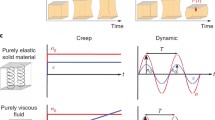Abstract
The concept of cell adhesiveness was analyzed by looking for correlations between the adhesive behavior and measurable biological properties of different cell populations. Ten established lines of melanoma cells were assayed for passive deformability (by micropipet aspiration), active spreading (by measuring the height/diameter ratio after incubation on different surfaces), density and mobility of concanavalin A binding sites (by quantitative analysis of fluorescence microscopic images), spontaneous and concanavalin A-mediated agglutination (by measuring the number of cell conjugates resisting calibrated shearing forces), and binding to glass capillary tubes (with a quantitative assay of binding strength). Forty-four different parameters were thus measured, and each set of determinations was repeated 2 or 3 t at different days on each cell line. Analysis of variance was performed to assess the capacity of each parameter to discriminate between different lines. Correlations between different parameters were studied in order to understand a possible influence of cell intrinsic properties on the behavior of individual cells. The following conclusions were suggested by experimental data
-
1.
Cell spreading ability, resistance to slow deformation within a micropipette and ability to form shear-resistant bonds, are independent properties. It is therefore suggested that different mechanisms rule the cell deformations on time scales of several minutes, tens of seconds, and fractions of a second.
-
2.
Cell spreading ability may effectively influence binding strength only when adhesive stimuli are low, since in this case, cell stiffness is likely to impair the formation of extensive contact areas.
-
3.
Individual cells may display marked heterogeneity within a given population, that emphasizes the danger of using averaged parameters to predict rare events (such as metastasis formation).
-
4.
The most useful parameters to discriminate between different cell lines were, spreading ability and shear-resistant lectin agglutination, and substrate adhesion.
It is concluded that cell adhesion is influenced by several measurable cellular properties that may display independent variations. The importance of a given parameter depends on the conditions of bond formation and rupture.
Similar content being viewed by others
References
Briles, E. B. and Kornfeld, S. (1978),J. Natl. Cancer Inst. 60, 1217–1221.
Yogeeswaran, G., Stein, B.S., and Sebastian, H. (1978),Cancer Res. 38, 1336–1344.
Raz, A., Bucana, C., McLellan, W., and Fidler, I. J. (1980),Nature 284, 363, 364.
Raz, A. and Geiger, B. (1982),Cancer Res. 42, 5183–5190.
Lotan, R. and Raz, A. (1983),Cancer Res. 43, 2088–2093.
Volk, T., Geiger, B., and Raz, A. (1984),Cancer Res. 44, 811–824.
Ochalek, T., Nordt, F. J., Tullberg, K., and Burger, M. M. (1988),Cancer Res. 48, 5124–5128.
Reich, S., Rosin, H., Levy, M., Markash, R., and Raz, A. (1984),Exp. Cell Res. 153, 566–560.
Fogel, M., Altevogt, P., and Schirrmacher, V. (1983),J. Exp. Med. 157, 371–376.
Hochman, J., Levy, E., Mador, N., Cottesman, M. M., Shearer, G. M., and Okon, E. (1984),J. Cell Biol. 99, 1282–1288.
Capo, C., Benoliel, A. M., Bongrand, P., Mishal, Z., and Berebbi, M. T. (1985),Immunol. Invest. 14, 27–40.
Wright, T. C., Ukena, T. E., Campbell, R., and Karnovsky, M. J. (1977),Proc. Natl. Acad. Sci. (U.S.A.) 74, 258–262.
Leung-Tack, J., Capo, C., Delapeyriere, O., Benoliel, A. M., Arnaud, D., and Bongrand, P. (1988),Int. J. Cancer 42, 946–951.
Marslow, D. E. (1989),Invasion Metastasis 9, 182–191.
Bongrand, P., ed. (1988),Physical Basis of Cell-Cell Adhesion, CRC Press, Boca Raton.
Aubert, C., Janiaud, P., Rouge, F., Hansson, C., Rorsman, H., and Rosengren, E. (1980),Ann. Clin. Res. 12, 288–294.
Aubert, C., Rouge, F., and Galindo, J. R. (1980),J. Natl. Cancer Inst. 64, 1029–1040.
Aubert, C., Rouge, F., and Galindo, J. R. (1984),J. Natl. Cancer Inst. 72, 3–12.
Bongrand, P. and Golstein, P. (1983),J. Immunol. Methods 58, 209–224.
Capo, C., Garrouste, F., Benoliel, A. M., Bongrand, P., Ryter, A., and Bell, G. I. (1982),J. Cell Sci. 56, 21–48.
Mège, J. L., Capo, C., Benoliel, A. M., and Bongrand, P. (1986),Cell Biophys. 8, 141–156.
Mège, J. L., Capo, C., Benoliel, A. M., Foa, C., and Bongrand, P. (1985),J. Immunol. Methods 82, 3–15.
André, P., Capo, C. Benoliel, A. M., Buferne, M., and Bongrand, P. (1990),Cell Biophys., in press.
Mège, J. L., Capo, C., Benoliel, A. M., and Bongrand, P. (1987),Biophys. J. 52, 177–186.
Snedecor, G. W. and Cochran, W. G. (1980),Statistical Methods, Iowa State University Press, Ames, pp. 215–237.
Weiss, L. and Clement, K. (1969),Exp. Cell. Res. 58, 379–387.
Weiss, L. and Dimitrov, L. (1984),Cell Biophys. 6, 9–22.
Nicolson, G. L. (1971),Nature New Biol. 233, 244–246.
Fernandez, S. M. and Berlin, R. D. (1976),Nature 264, 411–415.
Schmid-Schonbein, G. W., Sung, K. L., Tozeren, H., Skalak, R., and Chien, S. (1981),Biophys. J. 36, 243–256.
Evans, E. A. and Kukan, B. (1984),Blood 64, 1028–1035.
McClay, D. R., Wessel, G. M., and Marchase, R. B. (1981),Proc. Natl. Acad. Sci. (U.S.A.) 78, 4975–4979.
Somers, S. D., Mastin, J. P., and Adams, D. O. (1983),J. Immunol. 131, 2086–2093.
Bell, G. I., Dembo, M., and Bongrand, P. (1984),Biophys. J. 45, 1051–1064.
McCloskey, M. A. and Poo, M. M. (1986),J. Cell Biol. 102, 2185–2196.
André, P., Capo, C., Benoliel, A. M., Foa, C., Galindo, J. R., and Bongrand, P. (1990),Biorheology, in press.
Weiss, L. (1961),Exp. Cell. Res. 25, 504–517.
Weiss, L. and Coombs, R. R. A. (1963),Exp. Cell. Res. 30, 331–338.
Author information
Authors and Affiliations
Rights and permissions
About this article
Cite this article
Andre, P., Capo, C., Benoliel, AM. et al. Splitting cell adhesiveness into independent measurable parameters by comparing ten human melanoma cell lines. Cell Biophysics 17, 163–180 (1990). https://doi.org/10.1007/BF02990495
Received:
Accepted:
Issue Date:
DOI: https://doi.org/10.1007/BF02990495




